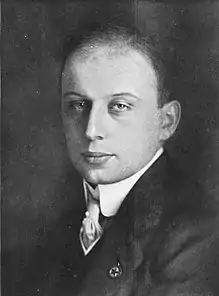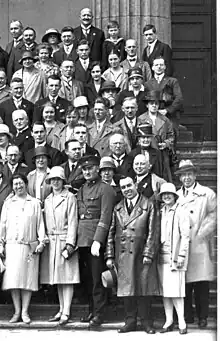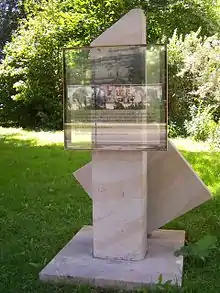Heinrich Arnhold | |
|---|---|
 Heinrich Arnhold (1908) | |
| Born | July 22, 1885 Dresden, German Empire |
| Died | October 10, 1935 Dresden, Nazi Germany |
| Nationality | German |
| Occupation(s) | Banker, Collector, Patron, Esperantist |
| Known for | Art collection, Patronage, Esperanto advocacy |
| Spouse | Lisa Mattersdorff (m. 1914) |
| Children | Ruth, Sigrid, Rainer, Esther, Heinrich-Hartmut (Henry H. Arnhold) |


Heinrich Arnhold, in full Heinrich Gustav Arnhold (born July 22, 1885, in Dresden; died October 10, 1935, in Dresden) was a German banker, collector, patron and esperantist.[1]
Life and work
Arnhold came from the Dresden banking family; Georg Arnhold was his father, Max Arnhold his uncle. Both had built up Arnhold Brothers into the largest private bank in Saxony.
His upbringing was shaped by the upper-middle-class and progressive atmosphere of his parental home. In 1907 he attended the 16th World Peace Congress in Munich with his father, a patron of the German Peace Society. Inspired by Bertha Suttner, he learned Esperanto at an early age. His teacher was the Dresden Esperanto poet Marie Hankel. In 1908 he was one of the organizers of the 4th Esperanto World Congress in Dresden. From 1911 to 1914 he was 1st chairman of the Saxon Esperanto Federation, from 1912 also treasurer of the German Esperanto Federation.
Heinrich Arnhold studied law and received his doctorate in law from the University of Leipzig in 1908. He joined the bank as a partner in 1910.
In 1914 he married Lisa, née Mattersdorff (1890-1972), also from a Dresden banking family. The couple had five children: Ruth, later married Steiner (1914-2001), Sigrid, later married Edwards († before 1992), Rainer († 1993), Esther, later married Seligmann (1918 - May 5, 2000),[2] and Heinrich-Hartmut (Henry H. Arnhold). The family home on Tiergartenstraße was a social gathering place and the site of Arnhold's discussion evenings.[3] In 1927, Arnhold had the garden of the house redesigned by Erwin Barth.[4] Heinrich and Lisa Arnhold built up a significant collection of modern art as well as, with encouragement from the family's investments in the porcelain and ceramics industry, an extensive collection of Meissen porcelain.[5][6]
Arnhold was a co-founder of the Society of Sponsors and Friends of the Dresden University of Technology (Gesellschaft der Förderer und Freunde der Technischen Hochschule Dresden, GFF) and was named its honorary senator for his long-standing commitment to the university.
Nazi era
When the Nazis rose to power in 1933, Arnhold, his family and his business were persecuted because of his Jewish heritage.
At first he tried to defend himself against the beginning persecution of the Jews legally and through petitions. Arnhold suffered strokes in 1934 and 1935, as a result of which he died. His death was later recognized as related to Nazi anti-Jewish persecution.[7] His wife Lisa, with the help of her brother-in-law Kurt Arnhold, managed to save the family and the porcelain collection, first to Switzerland and then via Portugal and Brazil to the USA.[8]
According to Artdaily, Arnhold acquired Emil Nolde's "Buchsbaumgarten" in the sale of the Ismar Littmann collection at the Berlin auction house Max Perl in February 1935.[9] In 2000, the Lehmbruck Museum rejected a claim from the Littmann family, saying in the sale had taken place before the Nuremberg Laws were declared and the buyer (Arnhold) had been Jewish.[10] In 2021, however, the museum reversed its earlier decision, acknowledging that Ismar Littmann, his widow and his four children were racially persecuted by National Socialist Germany after March 30,1933 due to their Jewish descent and therefore had to sell their art collection.[11]
Legacy
Arnhold's son, Henry H. Arnhold, escaped German-occupied Norway for the United States in 1941. There, during World War II, he served in that country's army intelligence as one of the Ritchie Boys.[12] After the war he joined the family's now New York-based Arnhold and S. Bleichroeder; he became its non executive chairman in the 1970s.
Since 2001, the son Henry Arnhold has facilitated a lecture and discussion series jointly organized with the American Academy in Berlin by Dresden Heritage e.V. called the Lisa and Heinrich Arnhold Lecture.[13] The events take place twice a year.
Writings
- Das Stimmrecht lombardierter Aktien. Leipzig, Univ., Diss., 1908
Literature
- Heike Biedermann: Die Sammlung Lisa und Heinrich Arnhold. In: Von Monet bis Mondrian. 2006, S. 101–111
- Maureen Cassidy-Geiger (Hrsg.): The Arnhold collection of Meissen porcelain 1710-50. [Exhibition The Arnhold Collection of Meissen Porcelain, 1710–50, March 25 - June 29, 2008]. New York: Frick Collection 2008, ISBN 978-1-904832-44-7, ISBN 978-0-912114-39-2
- Simone Lässig: Nationalsozialistische "Judenpolitik" und jüdische Selbstbehauptung vor dem Novemberpogrom. Das Beispiel der Bankiersfamilie Arnhold. In: Reiner Pommerin (Hrsg.): Dresden unterm Hakenkreuz. (Dresdner historische Studien 3) Weimar/Köln/Wien etc.: Böhlau 1998, ISBN 9783412111977, S. 129–192.
External links
- Arnhold Family Collection im Leo Baeck Institute (digitalisiert)
References
- ↑ Lins, Ulrich (2006). "Ulrich Lins: Heinrich Arnhold. Ein vergessener Pionier. In: Esperanto aktuell 2006/1, S. 8f". Esperanto Aktuell: 8.
- ↑ "Paid Notice: Deaths SELIGMANN, ESTHER (NEE ARNHOLD)". The New York Times. 2000-05-10. ISSN 0362-4331. Retrieved 2022-02-24.
- ↑ Flitter, Emily (2018-08-29). "Henry Arnhold, Patriarch of a Storied Banking Family, Dies at 96". The New York Times. ISSN 0362-4331. Archived from the original on 2018-08-29. Retrieved 2022-01-30.
Heinrich-Hartmut Richard Gustav Arnhold was born on Sept. 15, 1921, in Dresden, the fourth child of Lisa and Heinrich Arnhold, whose regular salons in their spacious home were attended by famous figures in the arts and sciences, including Albert Einstein and Wassily Kandinsky.
- ↑ "Architekturmuseum der TU Berlin". Architekturmuseum Berlin. 2022-01-30. Retrieved 2022-01-30.
- ↑ Cassidy-Geiger, Maureen; Arnhold, Heinrich; Arnhold, Henry; Arnhold, Lisa; Biedermann, Heike; Kuhn, Sebastian; Frick Collection (2008). The Arnhold Collection of Meissen porcelain, 1710-1750. New York; London: The Frick Collection in association with ; D Giles Ltd. ISBN 978-1-904832-44-7. OCLC 1008442697.
- ↑ "Henry Arnhold's Meissen Palace: Celebrating a Collector | The Frick Collection". www.frick.org. Retrieved 2022-02-24.
- ↑ Flitter, Emily (2018-08-29). "Henry Arnhold, Patriarch of a Storied Banking Family, Dies at 96". The New York Times. ISSN 0362-4331. Retrieved 2022-02-24.
Mr. Arnhold's governing principle, according to his family and close friends, was to seek companionship and joy — through good food, tennis and art — while eschewing any dark view of humanity that might accompany his status as a Holocaust survivor. He did so, they said, despite having watched his father die under extreme stress in Nazi Germany and, soon after, losing his home and friends in Dresden, which was firebombed extensively near the end of the war and suffered extensive damage.
- ↑ "Lost Art Internet Database - Jüdische Sammler und Kunsthändler (Opfer nationalsozialistischer Verfolgung und Enteignung) - Arnhold, Lisa". 2017-06-22. Archived from the original on 22 June 2017. Retrieved 2022-01-30.
Arnhold, Lisa;Lebensdaten geb. 1890, gest. 1972;Beruf Bankier;Angehörige;Arnhold, Heinrich, gest. 1935;Adresse Dresden;Firmensitz, -name, -gründung Zugehörig zur Bankiersfamilie Bankhaus Gebrüder Arnhold, waren Mehrheitseigner der Bank Adler, 1931 Interessengemeinschaft mit Bankhaus S. Bleichröder eingegangen.;Schicksal Flüchtete Ende 1936 in die Schweiz. 1938 Emigration in die USA.;Sammlung Die Sammlung enthielt Möbel, Leuchter, Plastiken und Silber.;Enteignung Lisa Arnhold begann bereits im November 1935 Teile ihrer Sammlung ins Ausland zu bringen. Lieferte viel in Galerie Fischer/ Zürich ein, dortige Auktionen 1940, 41, 42. Erlöse der Versteigerungen gingen an Gebr. Arnhold & S. Bleichröder in New York.;Quelle Tisa Franicisi, Esther, Heuss, Anja, Kreis, Georg, "Fluchtgut – Raubgut. Der Transfer von Kulturgütern in und über die Schweiz 1933 – 1945 und die Frage der Restitution", Veröffentlichungen der Unabhängigen Expertenkommission Schweiz – Zweiter Weltkrieg, 1, Chronos-Verlag, Zürich 2001, S. 134, 160, 161.
- ↑ "Amicable solution for restitution claim: Ketterer Kunst to offer Emil Nolde painting with notable provenance". 2021-10-14. Archived from the original on 2021-10-14. Retrieved 2022-01-30.
It was acquired by Dr. Heinrich Arnhold, a Jewish banker and art collector from Dresden, for a price far below the reserve. Arnhold's widow was able to take the painting with her when she emigrated to the U.S.A. In 1956 she had the "Buchsbaumgarten" sold through the Stuttgarter Kunstkabinett of Roman Norbert Ketterer, Robert Ketterer's uncle. Gerhard Händler, then director of the Städtisches Kunstmuseum in Duisburg, today Stiftung Wilhelm Lehmbruck Museum, acquired the work for 3,600 D-Mark. In 1999 the heirs after Dr. Ismar Littmann filed their first return request with the Lehmbruck Museum in Duisburg
- ↑ "Provenance Research: Stiftung Wilhelm Lehmbruck Museum, Duisburg (Wilhelm Lehmbruck Museum Foundation, Duisburg)". www.lootedart.com. Retrieved 2023-12-07.
- ↑ "Stiftung Wilhelm Lehmbruck Museum hat Emil Noldes Gemälde „Buchsbaumgarten" restituiert | Kulturgutverluste". kulturgutverluste.de (in German). 2021-10-07. Retrieved 2023-12-07.
- ↑ "Henry H. Arnhold, transatlantic bride-builder and friend of the GHI, passes away at the age 96". www.ghi-dc.org. Retrieved 2022-01-30.
- ↑ "Liliane Weissberg Presents Inaugural Lisa and Heinrich Arnhold Lecture in the Arts, Staatliche Kunstsammlungen Dresden | Germanic Languages and Literatures". germanic.sas.upenn.edu. Retrieved 2022-01-30.